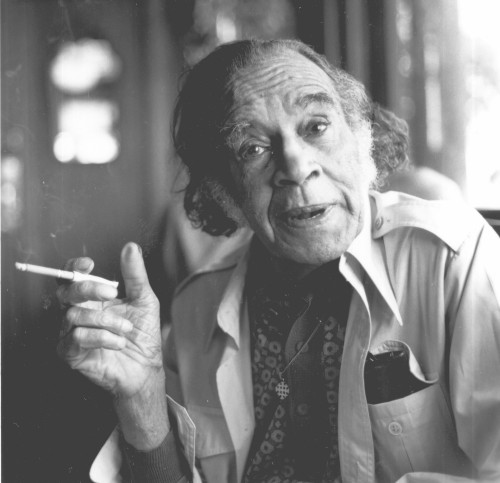Before Baldwin: The Writings of Richard Bruce Nugent
The African American literary critic and professor Henry Louis Gates once stated that the Harlem Renaissance was “surely as gay as it was Black, not that it was exclusively either of these.” This era witnessed the significant contributions of numerous queer black artists, performers, and literary figures, firmly intertwining queerness with the Harlem Renaissance’s legacy. Although many leading figures of the period, including Countee Cullen and Langston Hughes, are believed to have pursued same-sex relationships in their private lives, they maintained public personas that were mostly separate from their sexuality. Richard Bruce Nugent, who lived and wrote for much of his life in Greenwich Village, stands out as one of the only openly gay black writers of the era. That’s a distinction he would hold until James Baldwin published “Giovanni’s Room” in 1956.
Richard Bruce Nugent was born on July 2, 1906, in Washington, D.C. When he was thirteen, his father died of tuberculosis, so his mother, a skilled pianist, moved to New York for better work opportunities as a domestic servant. Nugent and his brother joined her later, residing in her apartment on West 18th Street and Eighth Avenue.

During his teenage years, Nugent fell in love with Greenwich Village. Nugent, young, bright, and socially outgoing, quickly immersed himself in the Village’s avant-garde scene. However when he expressed desire to become an artist, his mother opposed the notion and sent him to Washington, D.C to live with his grandmother. Ironically it was in D.C. that he encountered the vibrant culture of the Harlem Renaissance. Nugent became a regular attendee of Saturday salons hosted by poet Georgia Douglas Johnson. There, he met influential black writers, artists, and intellectuals, including Dr. Alain Locke. Through Douglas, Nugent also met Langston Hughes, whom he followed back to Harlem and integrated himself into Hughes’s close circle of friends. Hughes also played a pivotal role in launching Nugent’s career, rescuing his discarded poem “Shadow” from the trash and encouraging him to send the poem for publication in Opportunity magazine. “Shadow” became Nugent’s first published work.

Nugent became close friends with fellow writer Wallace Thurman and moved into his apartment on West 136th Street in Harlem. In 1926, Nugent, Hughes and Zora Neale Hurston became co-editors of Fire!!, a short-lived avant-garde journal started in Thurman’s apartment. In Fire!!, Nugent published the groundbreaking short story, “Smoke, Lilies, and Jade.” The story, written as a stream of consciousness, describes the romantic encounter between Alex, the protagonist and a clear surrogate for the author, and Beauty, a Latino stranger. Nugent’s biographer, Thomas Wirth, considers “Smoke, Lilies, and Jade” to be Nugent’s most important work. It was one of the first pieces of black literature to explicitly discuss black homosexuality and interracial desire.

From the Howard University Gallery of Art
In the 1930s, Nugent pursued various artistic endeavors, working as an artist, actor, and dancer. He drifted, staying with friends all around the city or with his mother back in Washington D.C. The 1940s brought him back to Greenwich Village where Nugent lived on Jane Street with his friends, Warren Marr II, a publicist who later became an editor of the NAACP’s journal, The Crisis, and his sister Grace Marr. Grace and Nugent developed a highly romantic yet platonic relationship and married in 1952.
In the ongoing decades, Nugent worked as a freelance artist, taking on odd jobs to supplement his modest income. In the late sixties, he joined other prominent African American artists and co-founded the Harlem Cultural Council, which played a pivotal role in the establishment of the Schomburg Center for Research in Black Culture.

By the seventies, there was a growing scholarly interest in the Harlem Renaissance. As one of its last surviving members, Nugent became an invaluable resource. Nugent and his story, “Smoke, Lilies,and Jade” were significant influences for the 1989 film “Looking for Langston,” and he was also interviewed for the documentary “Before Stonewall.” He passed away due to congenital heart failure in 1987. Interest in his legacy has grown significantly over the past decade. In 2008, his full-length novel Gentleman Jigger was published posthumously. This semi-autobiographical novel, written during the 1920s and 1930s, follows the main character, Stuart from Greenwich Village to Chicago, through Harlem’s vibrant literary scene and his romantic encounters with various Italian mobsters.
Henry Louis Gates underscored the importance of recognizing Nugent’s influence as literary and culture figure, because “he linked the black world of the Harlem Renaissance with the gay world of bohemian New York.” And of course that world ran squarely through Greenwich Village.

This was a great help with my american literature project!